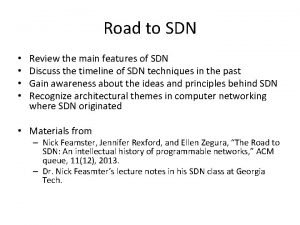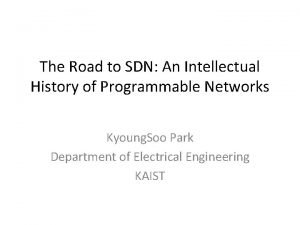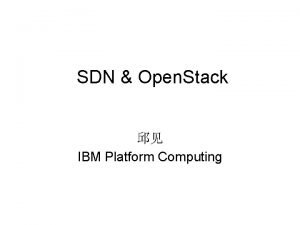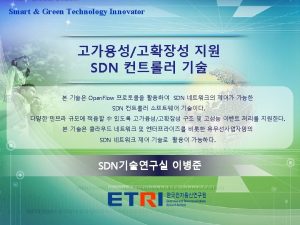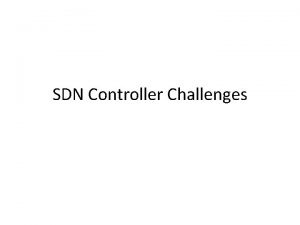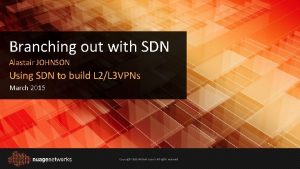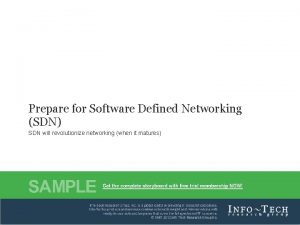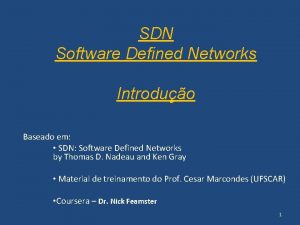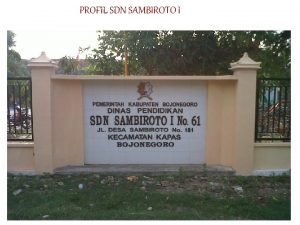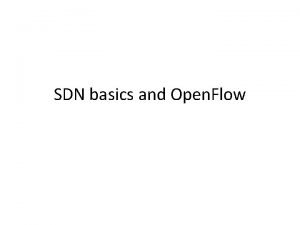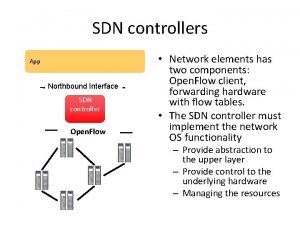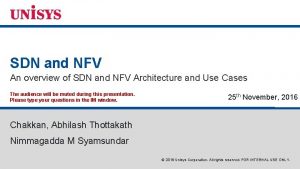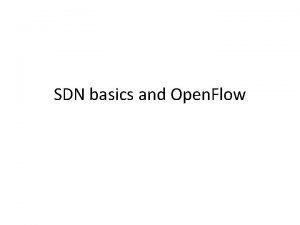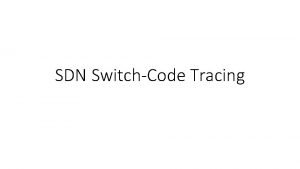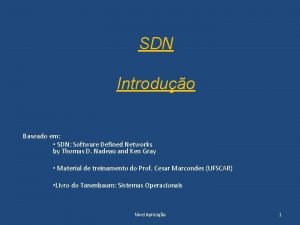The Road to SDN An Intellectual History of





















- Slides: 21

The Road to SDN: An Intellectual History of Programmable Networks Kyoung. Soo Park Department of Electrical Engineering KAIST

Paper Overview • How has the concept of SDN developed? – 20 years of compiled efforts • Summarizes the intellectual history of SDN • Three periods – Active networking – Control and data plane separation – Open. Flow and network OSes 2

Two SDN Characteristics • Why SDN? • Separating control plane from data plane – Control plane: how to handle the traffic – Data plane: forwards traffic based on the decisions that the control plane made • Consolidates the control plane – A single software program controls “multiple” dataplane elements – Direct control over the data-plane element’s state via well-defined API (e. g. , Open. Flow) 3

SDN Is a Hot Topic • Many interesting applications – Dynamic access control, server load balancing, network virtualization, energy-efficient networking, VM migration, etc. • Many big Internet companies show interest – Open Networking Foundation – Open Daylight Initiative 4

Active Networking • Between 1990 to 2000 – Tennenhouse and Wetherall • Make each networking node programmable – Capsule mode: code to execute is carried in-band in data packets – Programmable router/switch model: code to execute is established by out-of-band mechanisms – First “clean-slate” approach to network architecture • Anathema to existing concepts – “Network core should be simple and dumb” 5

Active Networking • Technology pushes – Reduction in the cost of computing – Reasonable to put some computing in the core – Java: platform portability, code execution safety – Advancement in rapid code compilation, formal methods – (Non technical) DARPA provide big funding 6

Active Networking • Use pulls – It’s too slow/hard to develop and deploy new services on the network (network ossification) – Third-party interest in value-added, fine-grain control to dynamically meet the needs of particular applications/network conditions – Researcher’s desire to experiment at scale – Unified control over middleboxes (firewalls, proxies, transcoders) • Remarkably similar to those of SDN! 7

Contributions of Active Networking • Programmability in the network to lower barrier to innovation – Pioneered the notion of programmable networks – AN focused more on data plane programmability – Isolation of experimental traffic from normal traffic • Demux to software programs on packet headers – Node. OS, Execution Environment (EE), Active Application (AA) – Direct packets to EE: fast pattern matching on headers • Unified architecture for middlebox orchestration – Early design documents hint at it – But never fully realized 8

Active Networking • Why not adopted? – Lack of compelling problem – Lack of clear path to deployment • No “Killer” application – Caching, content distribution, application-specific Qo. S, information fusion, …, but not enough 9

Separating Control and Data Planes • Circa. 2001 to 2007 • Conventional routers/switches embody a tight integration between the control and data planes – Debugging configuration problems is hard – Predicting/controlling routing behavior is hard • Why not separate control and data planes? 10

Separating Control and Data Planes • Technology push – The Internet grows rapidly – Packet forwarding implemented in hardware – Separate from software-based control plane – Servers have more memory and processing power than control-plane processors in a router • Open interface between the control/data planes – For. CES (Forwarding and Control Element Separation) – Netlink interface in Linux • Logically-centralize control of the network – Routing Control Platform (RCP) 11

Separating Control and Data Planes • Compared to Active Networking: • Focused on pressing problems in network management – By and for network administrators – Programmability in the control plane (rather than data plane) – Network-wide visibility and control (rather than device-level configuration) 12

Separating Control and Data Planes • Contributions: • Logically centralized control using an open interface to the data plane – IETF (For. CES) defined an open, standard interface to install forwarding-table entries – RCP used existing control plane protocol (BGP) to install forwarding-table entries • Distributed state management – A logically centralized controller must be replicated to cope with controller failure, but replication introduces inconsistent state across replicas 13

Separating Control and Data Planes • Criticism: no fate sharing – Logically-centralized route control could fail independently from forwarding devices – Centralized route control: each router has a purely local view of the “outcome” of the route selection • However, traditional distributed route selection also violates the principle – Moving packet forwarding to hardware means that the control plane software could fail independently from the data plane 14

Open. Flow and Network OSes • Success of experimental infrastructures – Planet. Lab – Emulab • Global Environment for Network Innovation (GENI) – Larry Peterson at SIGCOMM’ 05 • Stanford created Open. Flow (‘ 07) – Experimentation at a small scale: local campus network 15

Open. Flow and Network OSes • Open. Flow faces trade-offs – Fully programmable vs. pragmatic real-world deployment – Enabling more functions than route controllers – Building on commodity switches (limited flexibility) • Open. Flow API followed by NOX controller – Each rule has a pattern (matches bits on header) – A list of actions (drop, flood, forward, modify a header field, send the packet to controller) – Counters and priority 16

Open. Flow and Network OSes • Technology pushes – Industry adoption of Open. Flow: Broadcom opened API to control certain forwarding behaviors – Perfect storm for equipment vendors, chipset designers, network operators, networking researchers – Switches already support necessary functions – Start at a smaller scale and spread to a different venue (e. g. , data center networks) 17

Contributions of Open. Flow • Generalizing network devices and functions – Can define forwarding behavior based on any set of 13 different packet header fields – Same control on routers/switches/firewalls/NAT • The vision of a network operating system – From Node. OS (AN) to network OS (Open. Flow) • Distributed state management techniques – Multiple controllers for reliability, scalability, performance – Work together to look like a single logicallycentralized controller 18

Myths of Open. Flow • “The first packet of every flow should go to the controller”? – Ethane works this way, but others don’t need to – Open. Flow has no assumption about the granularity of rules or whether controllers handle any traffic – Some SDN applications only react to topology change • “SDN controllers must be centralized”? – No! ONIX and ONOS are distributed • “Open. Flow == SDN”? – Open. Flow is an instantiation of SDN principles 19

SDN • Simply, it’s a tool that enables innovation in network control – It does not solve any particular problem by itself • Can it be used to solve a pressing problem? – That previous tools couldn’t have solved well – Already showed some success in solving problems related to network virtualization 20

Homework • Paper reviews: Ethane and 4 D – I will present Ethane and discuss Ethane/4 D • Due on each class • Next time: 9/15 (Mon) • Have nice Chusuk! 21
 The road to sdn
The road to sdn Sdn history
Sdn history Paved road vs unpaved road
Paved road vs unpaved road Hát kết hợp bộ gõ cơ thể
Hát kết hợp bộ gõ cơ thể Slidetodoc
Slidetodoc Bổ thể
Bổ thể Tỉ lệ cơ thể trẻ em
Tỉ lệ cơ thể trẻ em Gấu đi như thế nào
Gấu đi như thế nào Tư thế worm breton
Tư thế worm breton Alleluia hat len nguoi oi
Alleluia hat len nguoi oi Kể tên các môn thể thao
Kể tên các môn thể thao Thế nào là hệ số cao nhất
Thế nào là hệ số cao nhất Các châu lục và đại dương trên thế giới
Các châu lục và đại dương trên thế giới Công của trọng lực
Công của trọng lực Trời xanh đây là của chúng ta thể thơ
Trời xanh đây là của chúng ta thể thơ Mật thư anh em như thể tay chân
Mật thư anh em như thể tay chân Phép trừ bù
Phép trừ bù độ dài liên kết
độ dài liên kết Các châu lục và đại dương trên thế giới
Các châu lục và đại dương trên thế giới Thể thơ truyền thống
Thể thơ truyền thống Quá trình desamine hóa có thể tạo ra
Quá trình desamine hóa có thể tạo ra Một số thể thơ truyền thống
Một số thể thơ truyền thống
